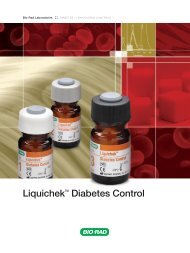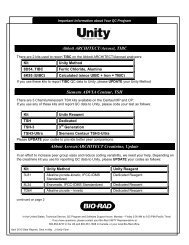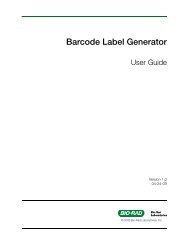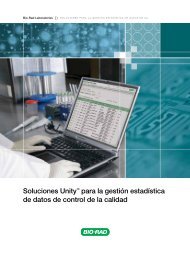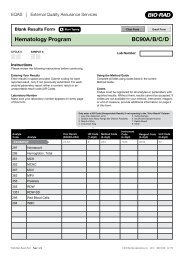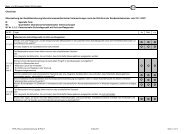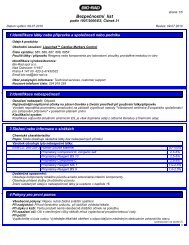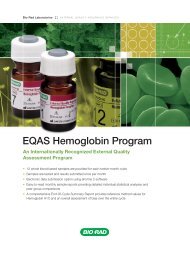EQAS Program User Guide - QCNet
EQAS Program User Guide - QCNet
EQAS Program User Guide - QCNet
You also want an ePaper? Increase the reach of your titles
YUMPU automatically turns print PDFs into web optimized ePapers that Google loves.
Chapter 5: <strong>EQAS</strong> Reports• Your individual sample results are plotted on the Y-axis (vertical) against the comparator meanvalues plotted on the X-axis (horizontal). Both axes are scaled to show the highest reported valueand start at zero. The ideal fit line is shown as a dashed line with an ideal slope of 1. The solid linesrepresent a 10% deviation of the ideal fit. This provides a quick visual evaluation of the correlationbetween your results and the comparator results. It also helps to identify bias at a particular area ofthe measurement range.• The top legend shows the Regression Line Slope, Intercept, and Correlation Coefficient for yourresults compared to the comparator (the comparator is shown in the chart title). 95% confidenceintervals for both slope and intercept are also provided. When the lab is compared at Peer level, theMethod Regression displayed is the Peer vs. the Method. If compared at Method level, the Methodcomparison is the Method vs. Mode. If compared at the Mode level, then the Method comparisondisplays the Mode vs. the Method. The Method Regression Line Slope, Intercept, and CorrelationCoefficient are shown in the top legend but not in the graph.6Comments sectionThis is available on every Analyte Summary Report and can be used to note comments or evaluations.The applicable report reviewer can sign and date their assessment of the report.64 <strong>EQAS</strong> <strong>Program</strong> <strong>User</strong> <strong>Guide</strong>





